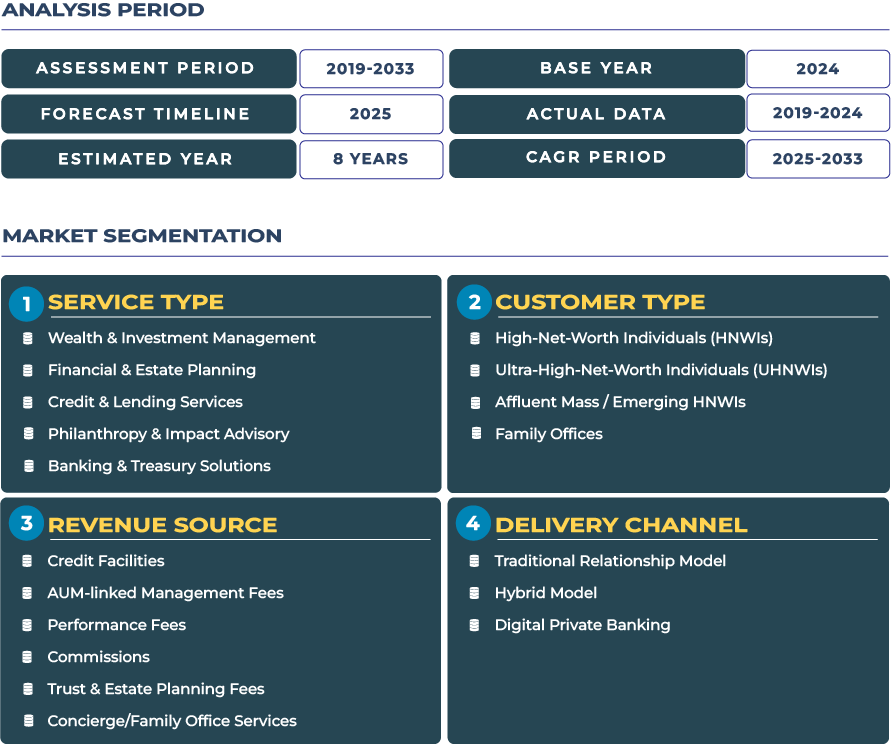US Private Banking Market Outlook: Shaping the Future of Modern Private Banking Services
In a zero-based mindset where every assumption is tested, the U.S. private banking ecosystem is undergoing a foundational reset rather than incremental evolution. The U.S. private banking market is projected to reach approximately USD 281.7 billion by 2025 and escalate to roughly USD 343.5 billion by 2033, representing a CAGR of about 2.5 % during the forecast period. This underscores that growth will be moderate-and success will hinge on structural adaptation rather than sheer volume expansion. The zero-theme suggests that private banks must strip back legacy models and rebuild around digitally-enabled advice, integrated client ecosystems, and new service constructs across deposits, lending, payments, investment services, insurance/bancassurance and treasury.
Note:* The market size refers to the total revenue generated by banks through various services.
Despite the slower growth path, the U.S. private banking landscape remains highly strategic: high-net-worth individuals (HNWIs) and ultra-HNWIs (UHNWIs) expect seamless global access, bespoke credit and liquidity solutions, targeted investment strategies and a single-platform experience. In the context of macroeconomic uncertainty-ranging from inflationary pressures and interest-rate shifts to geopolitical tensions and pandemic after-effects-private banking institutions must deploy resilience, agility and client segmentation sharply. The zero-focus thus signals the time for private banks to rebuild their models from the ground up and prepare for the next era of wealth advisory.
Growth Engines and Impediments: What’s Fueling-and Slowing-U.S. Private Banking Expansion
Key growth drivers. The U.S. private banking sector is propelled by the accumulation of wealth among HNWIs and UHNWIs, heightened demand for bespoke investment strategies (including alternatives), and the shifting interplay of client expectations toward holistic wealth ecosystems. Tech-savvy clients expect digital engagement, mobile access, real-time liquidity and seamless integration of banking, investment, and treasury services. Furthermore, the migration of high-net-worth households into tax-favourable states and increased cross-border wealth flows amplify demand for private banking platforms with global reach and sophisticated service architecture.
Major restraints. On the other hand, growth is challenged by structural impediments: regulatory burden and compliance costs remain high, limiting agility and increasing fixed-cost burdens. Market volatility, rising interest-rates, inflationary risk and geopolitical uncertainty weigh on discretionary investment flows and may suppress client risk appetite. Moreover, intensifying competition from non-bank wealth platforms and fintech challengers erodes traditional advisory margins. Legacy operating models in many private banks-designed for product-led delivery-are misaligned with the experience-centric, digital-capable demands of next-gen affluent clients. These factors temper the growth potential and shape the slower CAGR expectation.
Trend Lines & Opportunity Windows: Digitalisation, ESG Integration and Tailored Wealth Architecture
Emerging trend vectors. A significant trend in the U.S. private banking sector is the accelerated shift to digital-wealth architectures-combining mobile engagement, data-driven client insights and hybrid advice delivery. Clients now expect advisory platforms that link payments, credit, liquidity, investment and insurance services on one canvas. Additionally, ESG (environmental, social and governance) considerations are swiftly becoming standard in private wealth portfolios; affluent clients increasingly demand impact-oriented investments and sustainable banking frameworks.
Opportunity pathways. Private banks have opportunity to differentiate by offering alternative asset access (private credit, direct real estate, venture capital), concierge-style lending and treasury-optimised solutions for affluent clients. For example, regionally affluent hubs-such as Florida, Texas and California-are witnessing an influx of wealthy households seeking holistic private banking propositions. Firms that embed cross-service linkages (e.g., combining deposit loyalty, tailored credit, payments-based liquidity, investment advisory and insurance wrappers) will capture deeper wallet share. In sum, digital first, ESG-informed and experience-driven models present the strategic blueprint for winning in the evolving U.S. private banking market.
Competitive Landscape: Strategic Moves Setting the Pace in U.S. Private Banking
The competitive terrain in the U.S. private banking industry is dominated by major players such as JPMorgan Chase & Co., whose private banking arm continues to deepen its footprint and expand digital-wealth capabilities. For instance, in early 2025 the firm appointed David Frame as global CEO of its private bank, underscoring the strategic priority of affluent client relationships and cross-border wealth solutions. In parallel, other institutions are reshaping segmentation (distinguishing ultra-HNW from next-gen wealth), forming alliances for alternative-asset delivery, deploying embedded insurance/bancassurance and optimisation of payments/treasury flows for high-net-worth clients.







